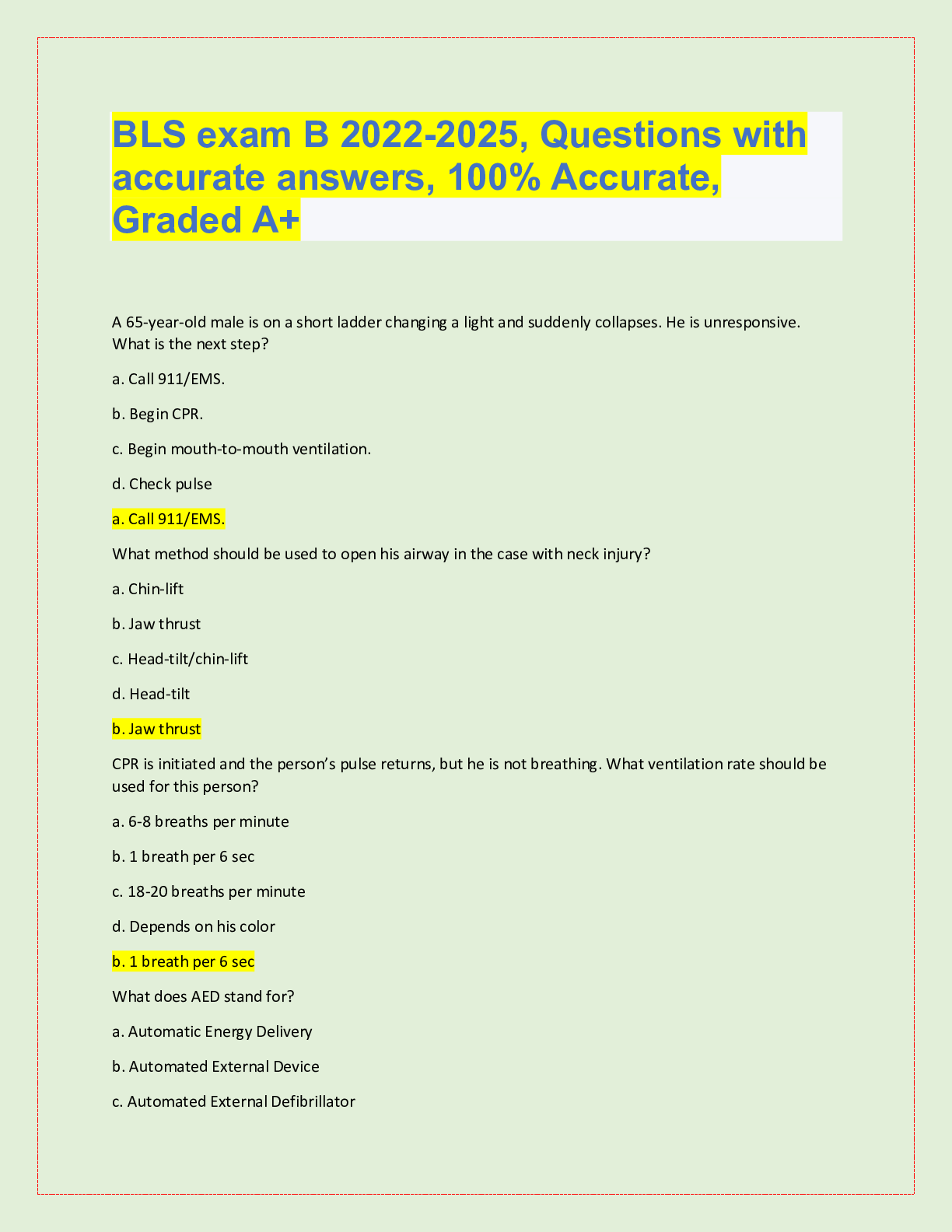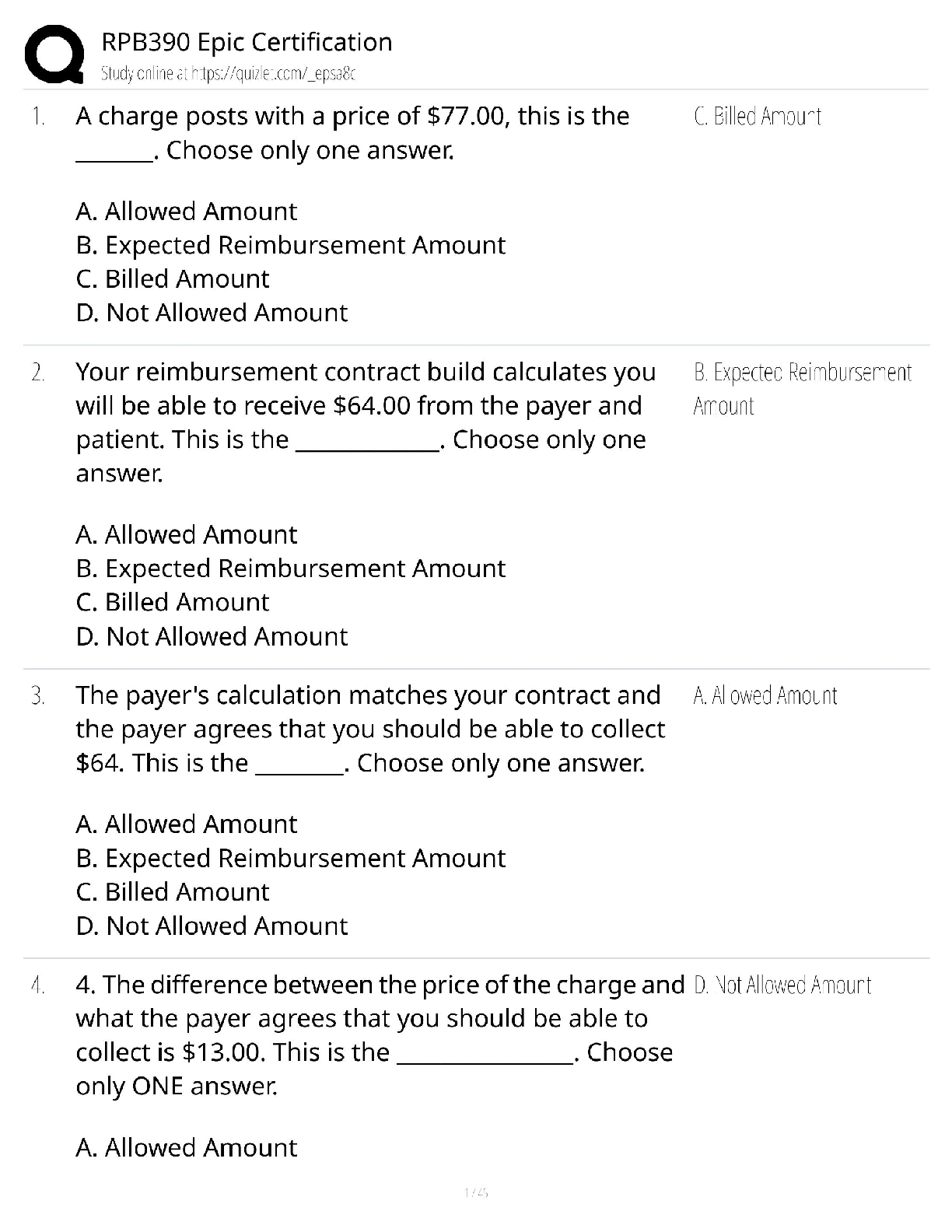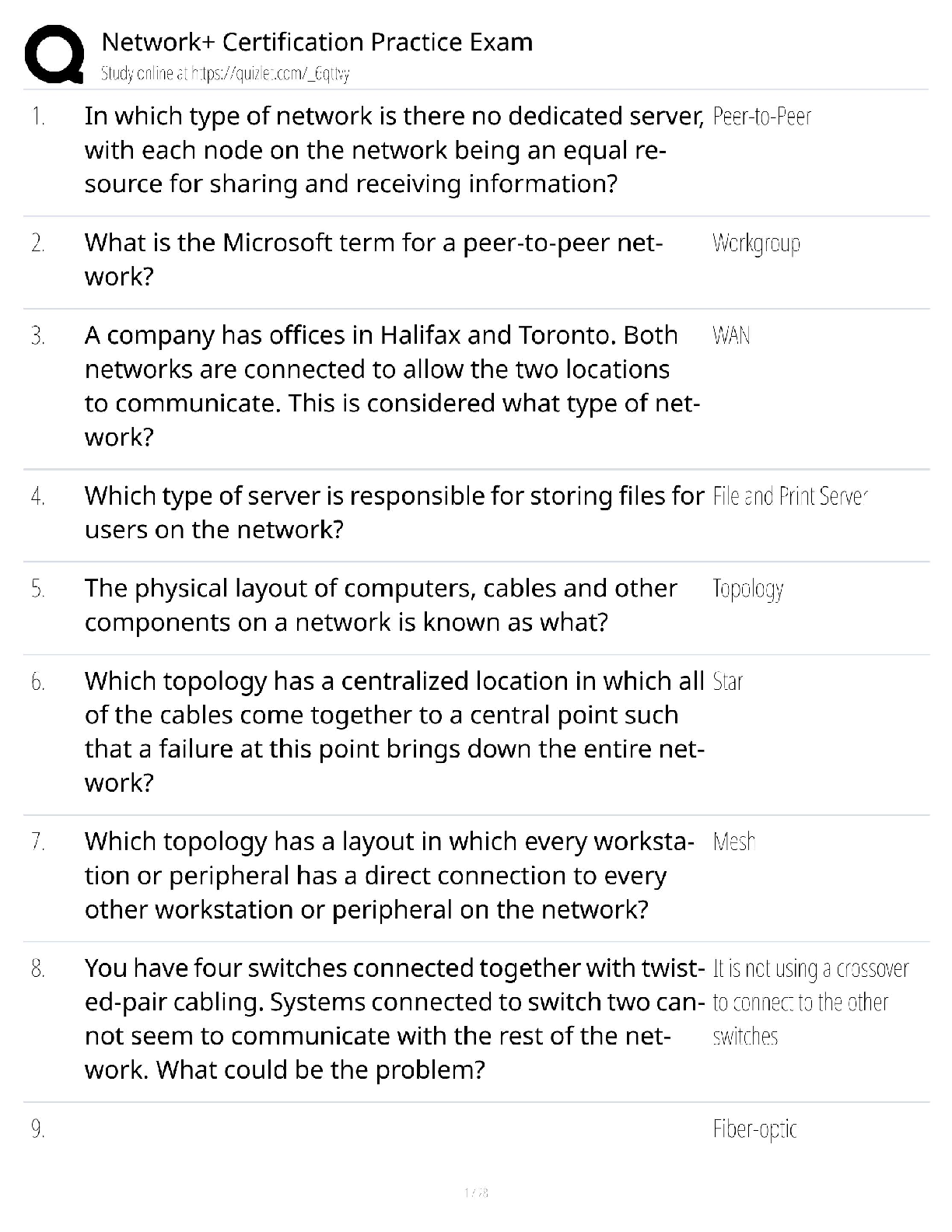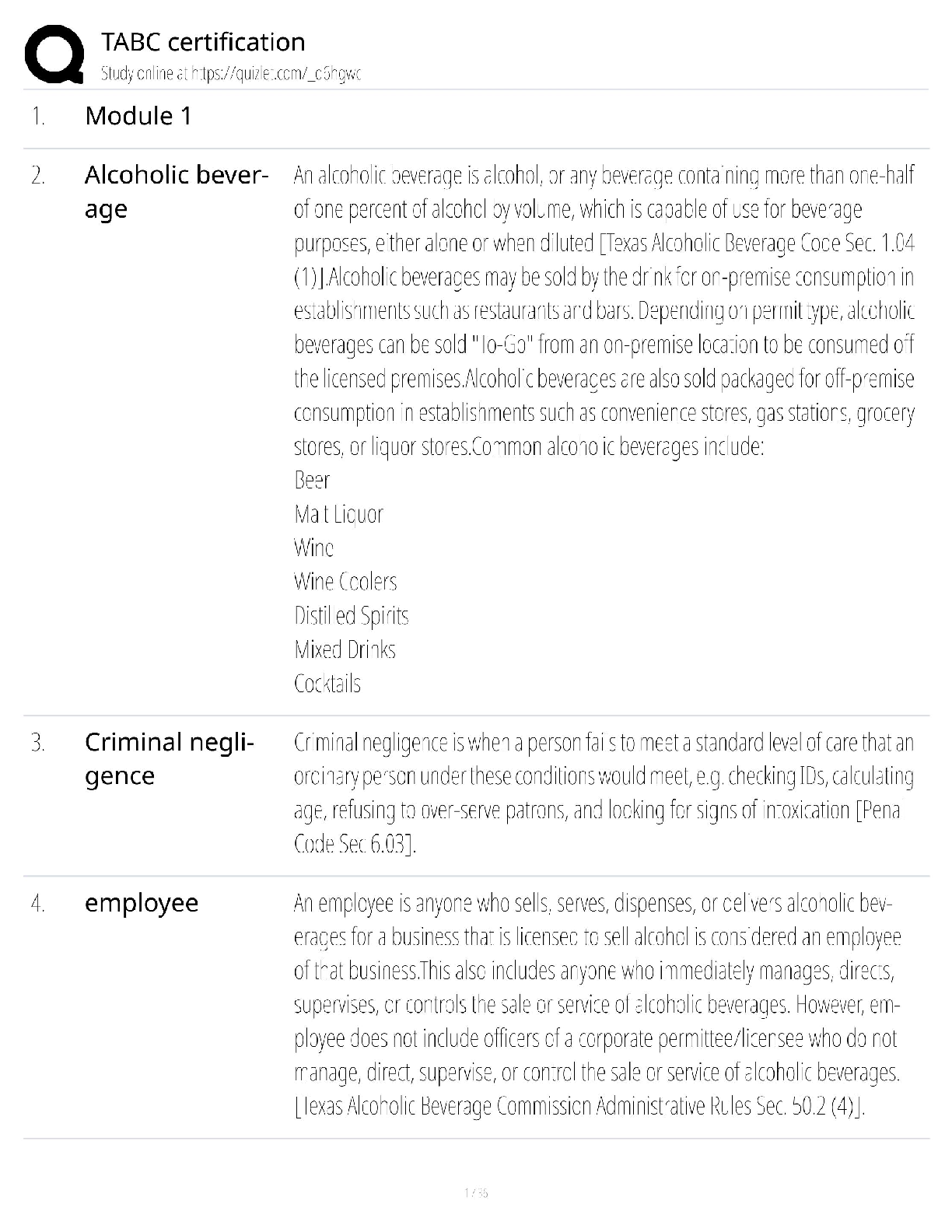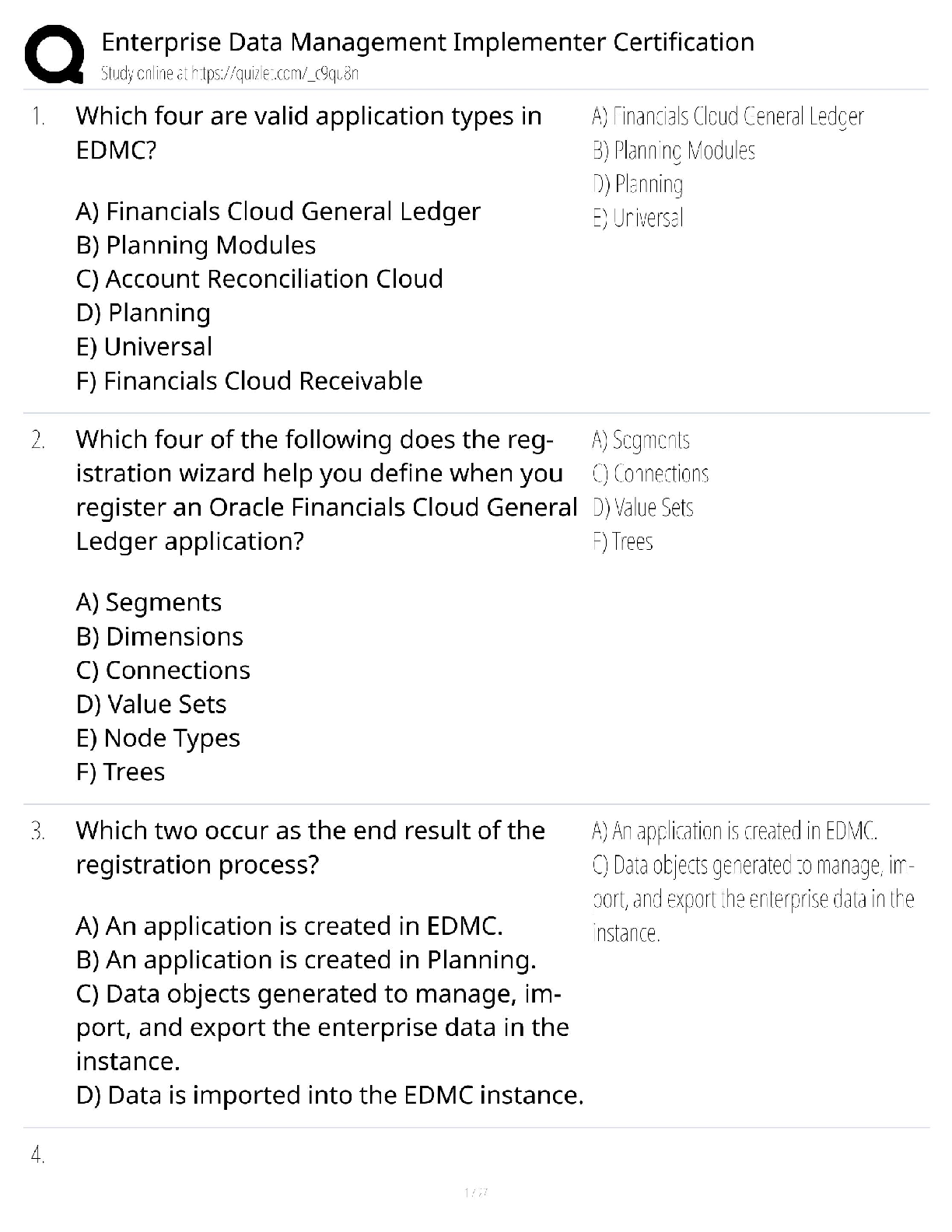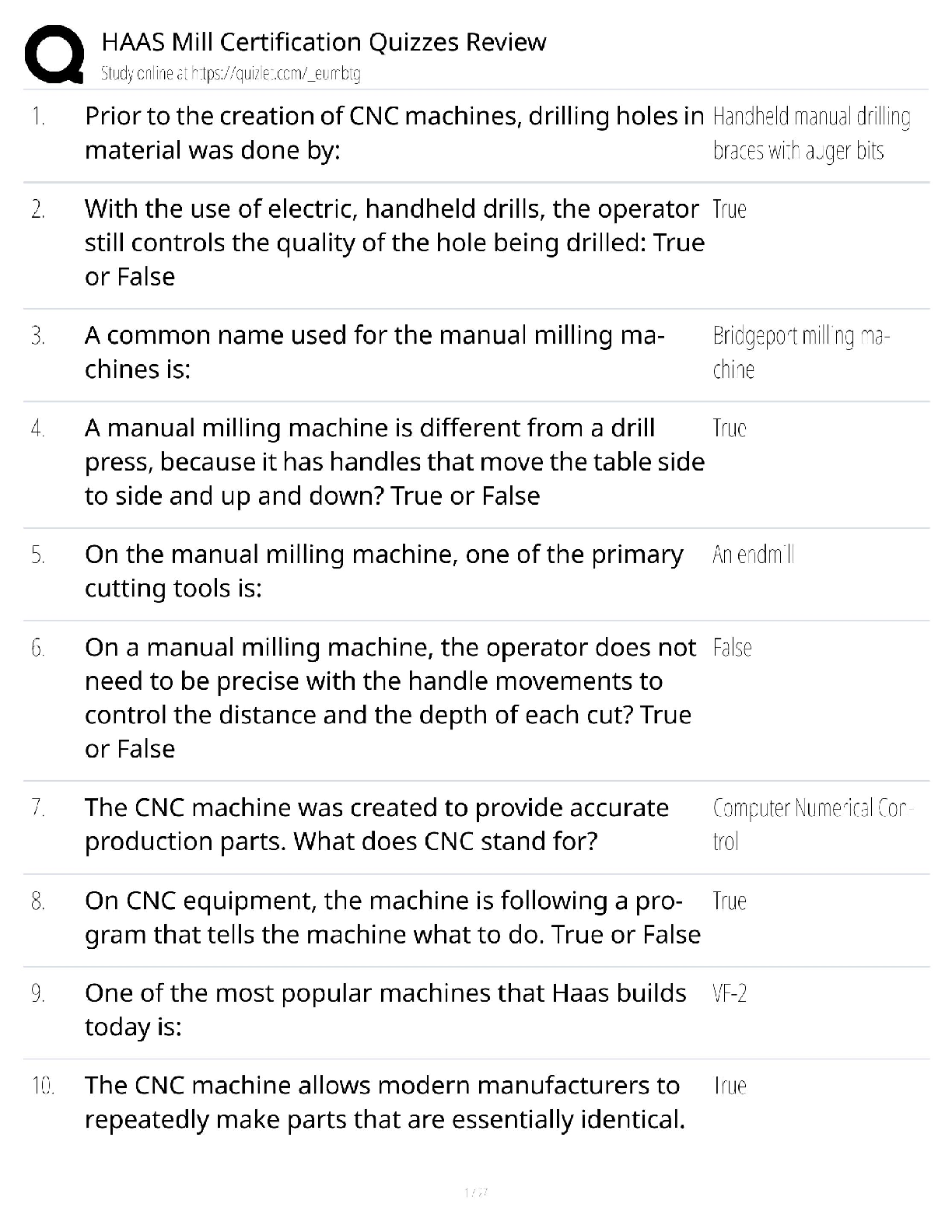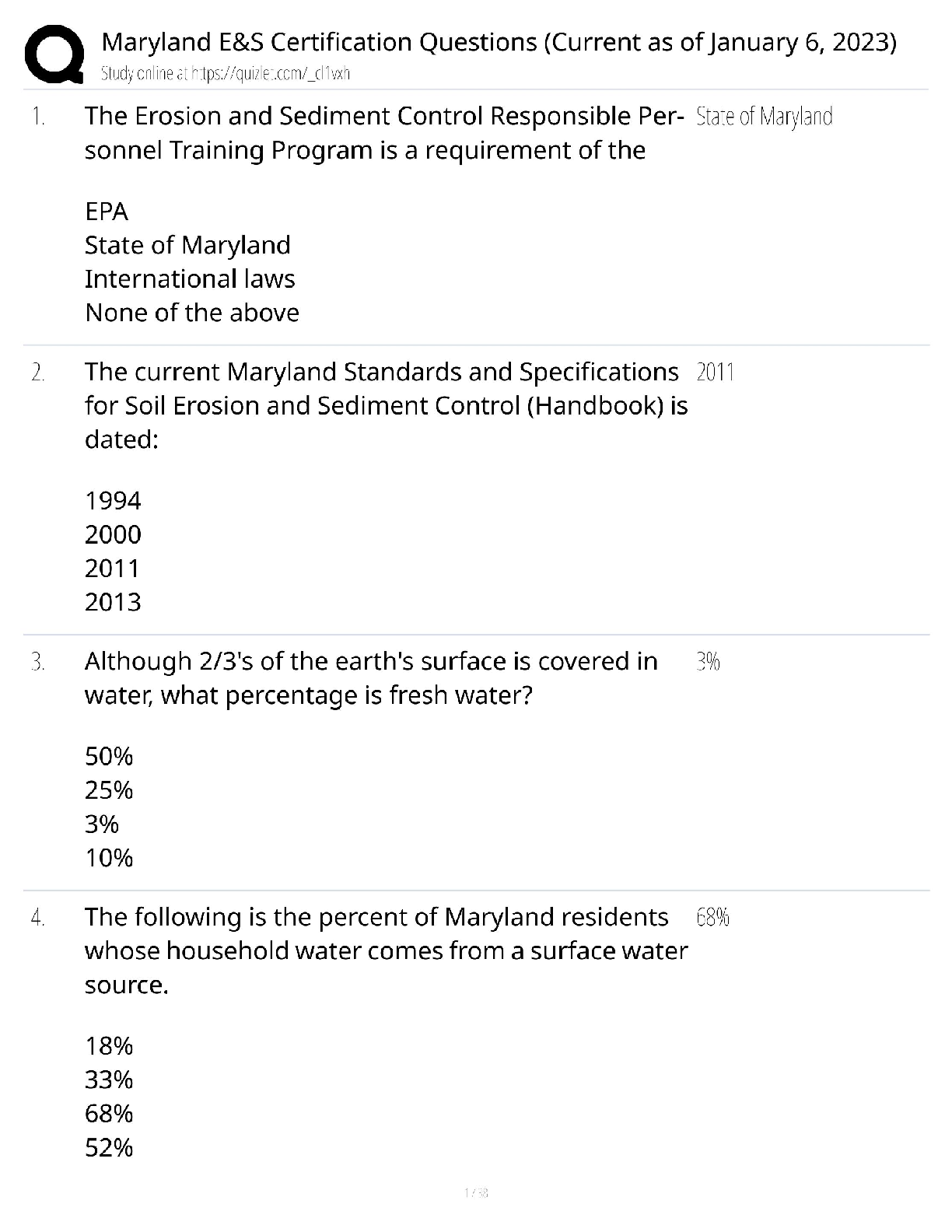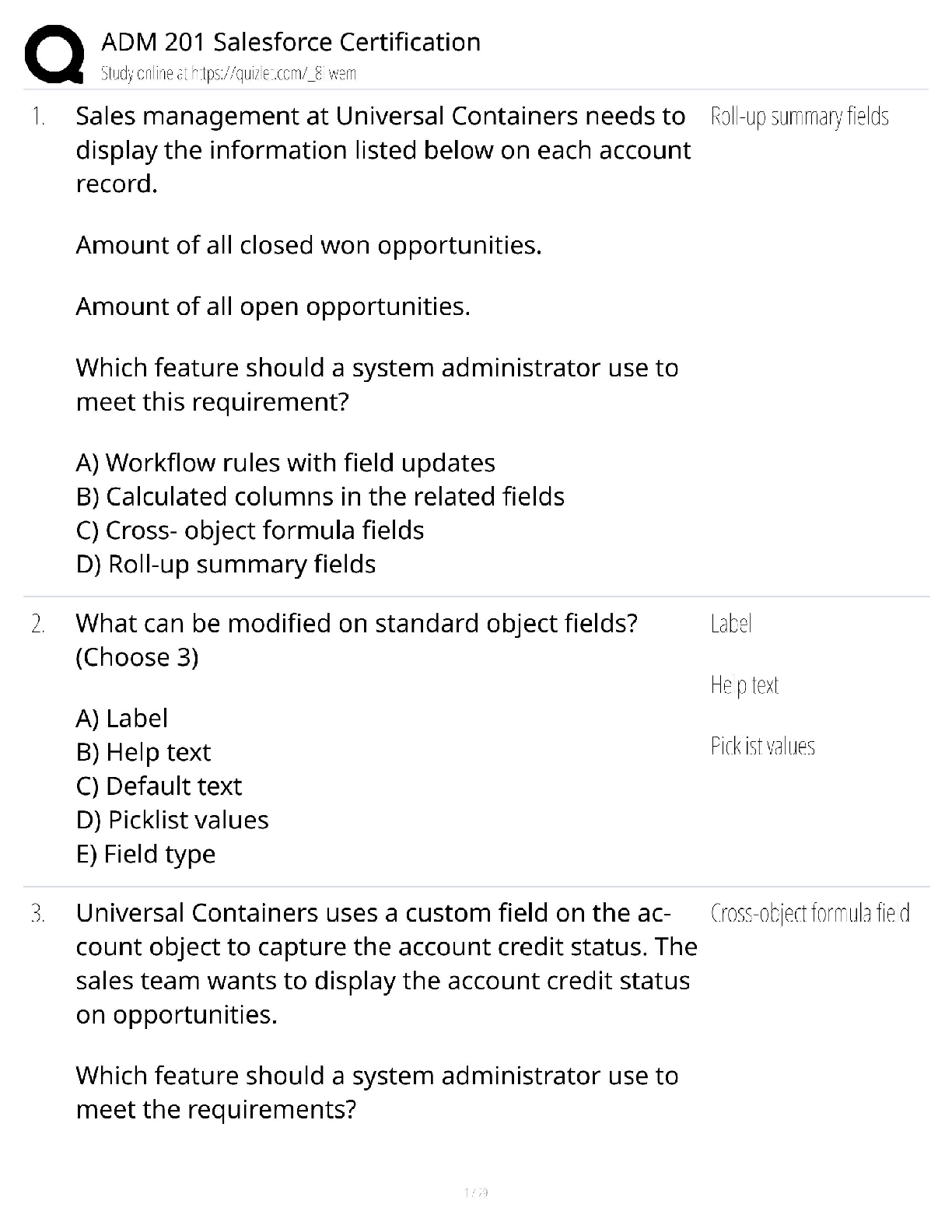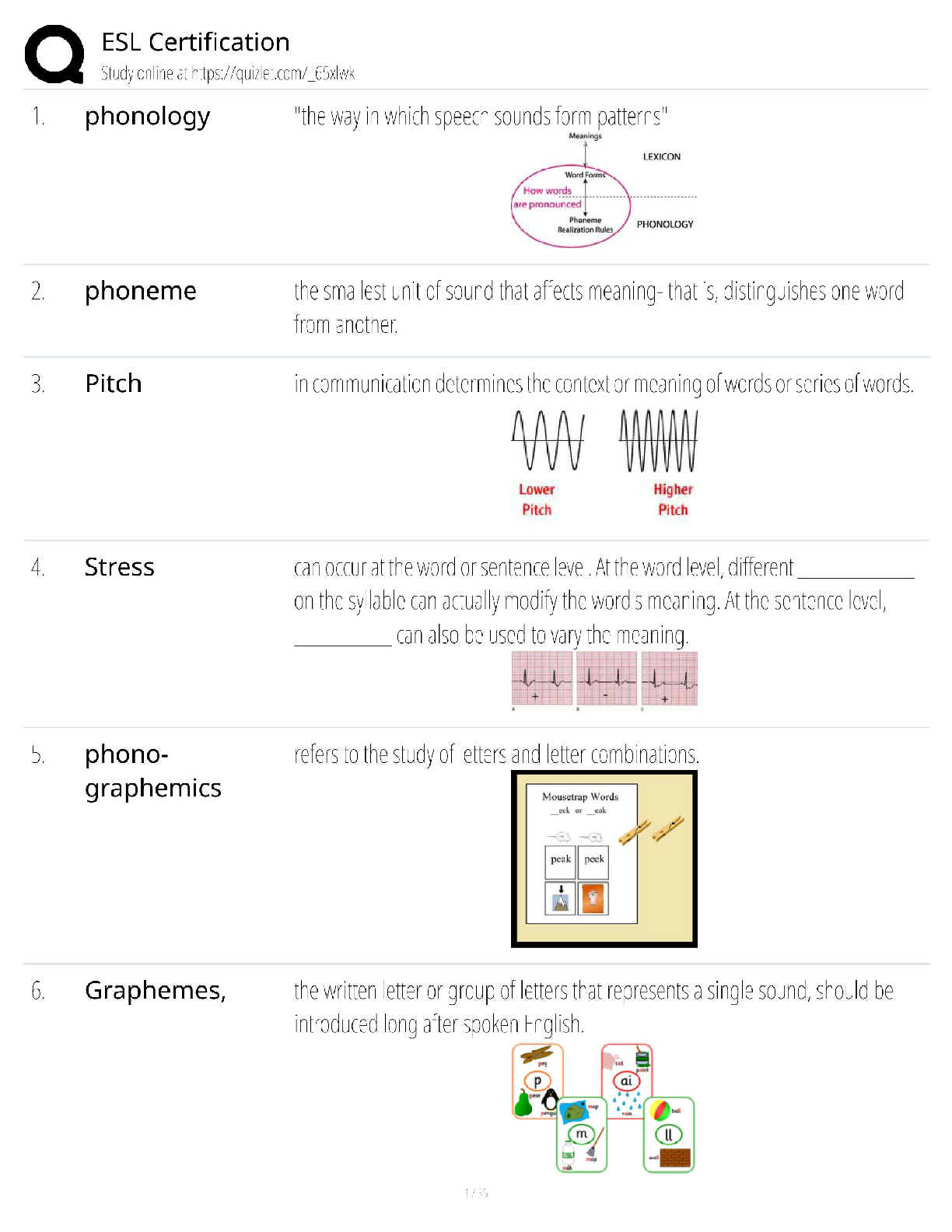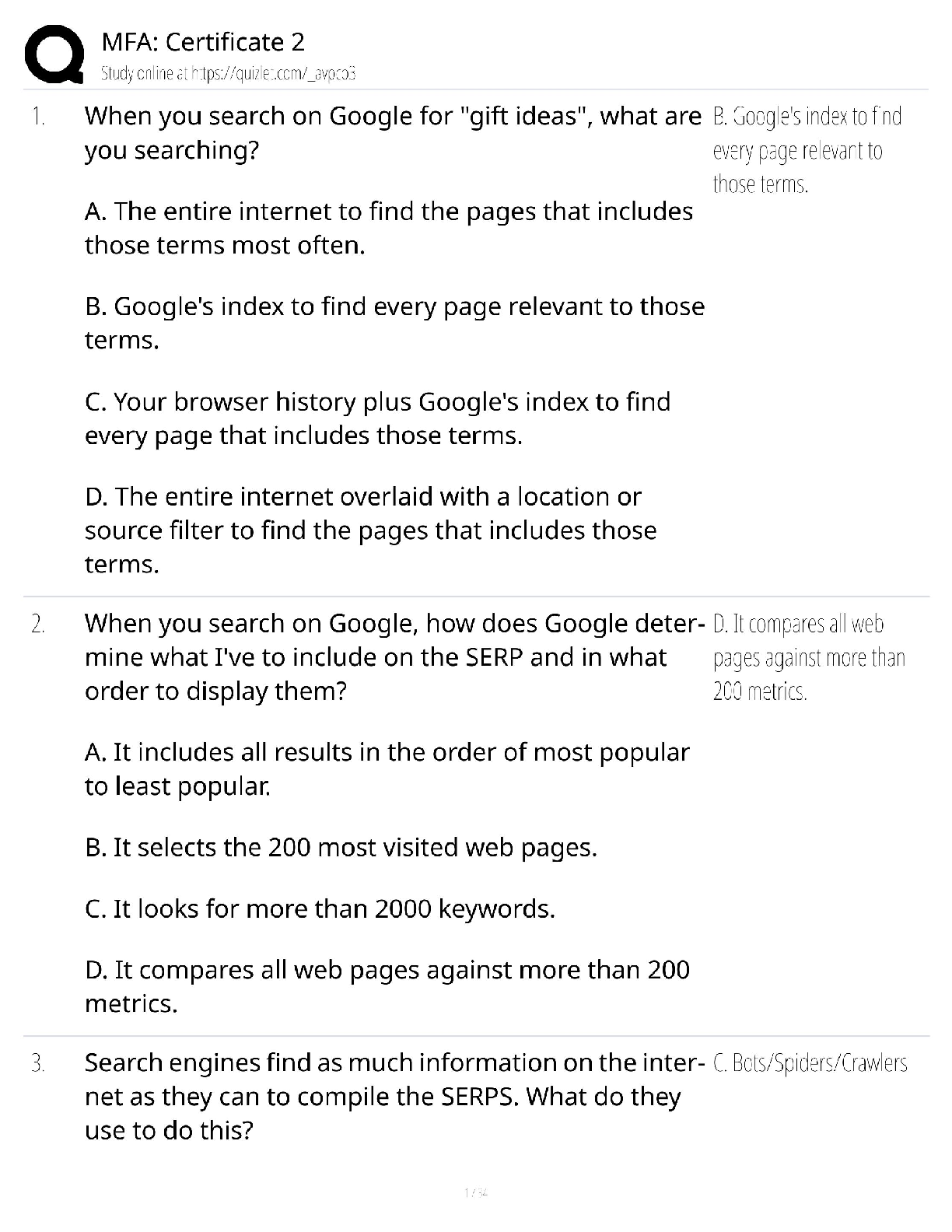Education > QUESTIONS & ANSWERS > FTCE Elementary Education k-6 Language Arts and Reading, Questions and answers. Exam Preview Quizz (All)
FTCE Elementary Education k-6 Language Arts and Reading, Questions and answers. Exam Preview Quizzes. Rated A
Document Content and Description Below
FTCE Elementary Education k-6 Language Arts and Reading, Questions and answers. Exam Preview Quizzes. Rated A The 5 Components of Reading - ✔✔-phonemic awareness, phonics, fluency, vocabula ... ry, comprehension Phonemic Awareness - ✔✔-The ability to hear and manipulate the sounds of spoken language. Includes noticing rhyme and recognizing the separate, small sounds in words (phonemes). Phonics - ✔✔-The understanding of the relationships between the written letters of the alphabet and the sounds of spoken language. This knowledge allows a reader to "decode" words by translating the letters into speech sounds. Fluency - ✔✔-The ability to read quickly, accurately, and with proper expression. Vocabulary - ✔✔-Includes all the words the reader can understand and use. Comprehension - ✔✔-Ability to understand what one has read. Includes recognizing main idea of article or able to compare and contrast different characters. Word Recognition - ✔✔-the student has ability to visually identify words in isolation or context. Phases of word recognition - ✔✔-pre-alphabetic, partial-alphabetic, full-alphabetic, graphophonemic, and morphemic. Text to self - ✔✔-the reader made a connection from the reading to own personal life. Text to text - ✔✔-the reader made a connection from the reading to another book with similar writing style, theme, or topic. Text to world - ✔✔-the reader made a connection from the reading to a topic or an event that has taken place in the world. Critical Thinking Strategies - ✔✔-making connections, making predictions, questioning, summarizing Making predictions - ✔✔-use title and illustration on cover to predict what a text will be about aids comprehension. Throughout reading, predictions can be affirmed or revised. Questioning - ✔✔-helps students make meaning of text being read. Questions about text, author's intent etc. "Right there" questions (text explicit) - ✔✔-literal questions. Answer in the text itself. "Think and search" (text implicit) - ✔✔-the answer is implicit in text. Student must synthesize, infer, or summarize to find answer. "Reader and author" (implicit or experienced based) - ✔✔-Reader must combine own experience with what texts states. "On my own" (implicit or experienced based) - ✔✔-Reader must generate answer from prior knowledge. Summarizing - ✔✔-to simply and concisely paraphrase what has been read. Reading Fluency - ✔✔-accuracy, automaticity, rate, prosody Accuracy - ✔✔-ability to correctly read the words in a text Automaticity - ✔✔-ability to instantly recognize a large bank of words to quickly decode unfamiliar words. Rate - ✔✔-speed of reading Prosody - ✔✔-ability to read with appropriate rhythm, intonation, and expression. Reading Comprehension - ✔✔-Main idea, supporting details and facts, author's purpose, fact and opinion, point of view, inference, visualize, conclusion Main idea - ✔✔-Determining the essential message of a reading selection. Supporting details and facts - ✔✔-provides the reader with the vital info needed to synthesize and summarize. Author's purpose - ✔✔-Could be to explain, inform, persuade, or entertain. Fact and opinion - ✔✔-Students should know difference when reading. Point of view - ✔✔-Students should be able to identify which __________ an author is writing. Inference - ✔✔-"Reading between the lines." Often includes merging what is already known about topic to new information presented. Visualize - ✔✔-Create mental pictures in one's mind. Conclusion - ✔✔-The end or summation of a reading. Facilitate student reading comprehension - ✔✔-activate prior knowledge, summarize, self-monitoring, questioning, use of graphic and semantic organizers, think alouds, recognizing story structure Activate prior knowledge - ✔✔-Students must connect what they hear, read, and view with what they already know. Can use Think-Pair-Share technique to discuss previous knowledge with partner. Graphic organizers (K-W-L charts) can elicit what students already know about topic. Summarize - ✔✔-Often included in a retelling of the selection. Think-Pair-Share techniques to discuss summary with partner. Self-monitoring - ✔✔-Being aware of their thinking as they are reading. Students must pause periodically to reflect about info. Questioning - ✔✔-Teachers must model different questions for students to internalize and implement in own reading. Use of graphic and semantic organizers - ✔✔-used by teachers and students to highlight big ideas in a text and facilitate connections. Organizers synthesize and summarize reading. Think alouds - ✔✔-"talking to the text." Involves teacher modeling her thoughts aloud while reading text to students. Vocabulary often incorporated to pre-teach new words and meanings. Then practiced by students and partners. Recognizing story structure - ✔✔-Beginning, middle, end with literary elements setting, characters, and plot. Teachers highlight and facilitate the analyzing of story structure through questioning techniques before, during, and after read aloud or shared reading. Informational or nonfiction text - ✔✔-is structured using organizational aids called text features. Helps summarize info presented. Title, table of contents, headings, subheadings, bold and italicized words, illustrations, photographs, labeled diagrams, charts, graphs, tables, glossary, index Graphic organizers - ✔✔-(cause and effect, venn diagrams, double entry journals, timelines) can be used to further explore content Literary text or narratives - ✔✔-have a logical sequence. Students can be taught to recognize beginning, middle, end. Emergent literacy - ✔✔-the beginning phase of literacy. Learn text and pictures provide meaning. Are exposed to structure or syntax of language and predict meaning of text. Emergent literacy - ✔✔-Oral language development, phonological awareness, alphabet knowledge, concepts of print Oral language development - ✔✔-enhance skills: be involved in open-ended (whole group, small group, and one-on-one) discussions, read alouds, echo reading, songs, nursery rhymes, storytelling, readers theater, cloze activities, poetry, role play and drama, fingerplays... Phonological awareness - ✔✔-includes ability of a student to identify and manipulate large parts of spoken language (words, syllables, onset/rime units) and awareness of other aspects of sound in our language like alliteration, intonation, and rhyming. Alphabet knowledge - ✔✔-ability to identify and name the upper and lowercase letters. Concepts of print - ✔✔-Should understand print conveys meaning, directionality, concept of word (word boundaries), one-to-one corresponding letter knowledge, phonemic awareness, and literacy language (author, illustrations, title...). Poetry - ✔✔-Contains short lines, imagery, and elements of sound, such as rhythm and rhyme. Folklore - ✔✔-Stories that were told by word of mouth: nursery rhymes, fairy tales, fables, myths, legends, tall tales, Fantasy - ✔✔-Stories that could not happen in the real world Science fiction - ✔✔-Stories that might happen in the future Realistic fiction - ✔✔-Stories focusing on events that could happen in the real world. Historical fiction - ✔✔-Realistic stories set in the past. Biography - ✔✔-Stories that tell the tale of a person's life Nonfiction - ✔✔-Books that present information. Literary Elements - ✔✔-Setting, Characters, plot, theme, style Setting - ✔✔-where the story takes place Characters - ✔✔-people or animals in a story, novel, or play Plot - ✔✔-the events that take place in a story; often includes a climax and resolution Theme - ✔✔-the subject or central idea of the story Style - ✔✔-the vocabulary and syntax the author uses to create the story Alliteration - ✔✔-two or more words or syllables, near each other, with the same beginning consonant Hyperbole - ✔✔-an exaggeration used to emphasize a point Analogy - ✔✔-a detailed and sometimes lengthy comparison of two ideas or events Irony - ✔✔-using words that mean the opposite of what the author intends Personification - ✔✔-giving human qualities to a thing or abstraction Metaphor - ✔✔-a comparison of two distinctly different things suggesting a similarity between them Simile - ✔✔-a comparison using like or as selecting quality multicultural lit books - ✔✔-Depicts diversity but avoids stereotyping Explores cultural differences and similarities Provides accurate and positive portrayal of culture represe [Show More]
Last updated: 2 years ago
Preview 1 out of 16 pages

Buy this document to get the full access instantly
Instant Download Access after purchase
Buy NowInstant download
We Accept:

Also available in bundle (1)
Click Below to Access Bundle(s)

FTCE BUNDLE, ALL EXAMS COVERAGE, GRADED A+ masterpieces.
FTCE General Knowledge- English practice test 1,2,3, &4. Questions Bank. Questions with accurate answers. Graded A+. ftce General Knowledge Practice Test (GK) Math. Questions with accurate answers, 1...
By Topmark 2 years ago
$30
18
Reviews( 0 )
$10.00
Can't find what you want? Try our AI powered Search
Document information
Connected school, study & course
About the document
Uploaded On
Mar 10, 2023
Number of pages
16
Written in
All
Additional information
This document has been written for:
Uploaded
Mar 10, 2023
Downloads
0
Views
162

